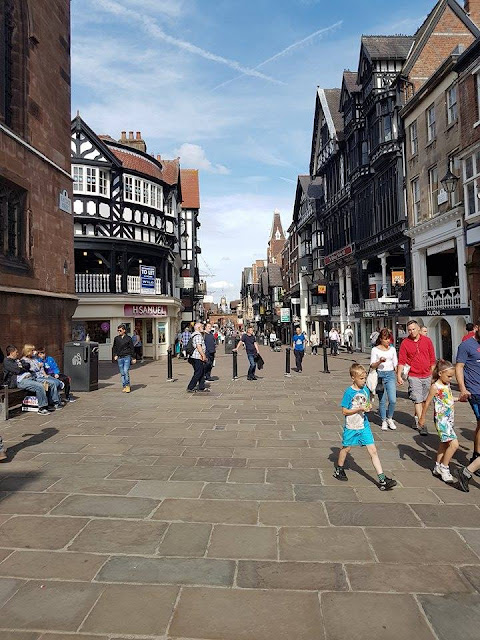The Dissolution of the Monasteries redistributed large amounts of land to the The Tudor architectural style is the final development of Medieval architecture in England, during the Tudor period (1485–1603) and even beyond, and also the tentative introduction of Renaissance architecture to England. It is generally not used to refer to the whole period of the Tudor dynasty (1485-1603), but in prestige buildings to the period roughly between 1500 and 1560. It followed the Late Gothic Perpendicular style and was superseded by Elizabethan architecture from about 1560 in domestic building of any pretensions to fashion. In the much more slow-moving styles of vernacular architecture "Tudor" has become a designation for styles like half-timbering that characterise the few buildings surviving from before 1485 and others from the Stuart period. In this form the Tudor style long retained its hold on English taste. Nevertheless, 'Tudor style' is an awkward style-designation, with its implied suggestions of continuity through the period of the Tudor dynasty and the misleading impression that there was a style break at the accession of Stuart James I in 1603.
The four-centered arch, now known as the Tudor arch, was a defining feature. Some of the most remarkable oriel windows belong to this period. Mouldings are more spread out and the foliage becomes more naturalistic. During the reigns of Henry VIII and Edward VI, many Italian artists arrived in England; their decorative features can be seen at Hampton Court Palace, Layer Marney Tower, Sutton wealthy, resulting in a secular building boom, as well as a source of stone. The building of churches had already slowed somewhat before the English Reformation, after a great boom in the previous century, but was brought to a nearly complete stop by the Reformation. Civic and university buildings became steadily more numerous in the period, which saw general increasing prosperity. Brick was something of an exotic and expensive rarity at the beginning of the period, but during it became very widely used in many parts of England, even for modest buildings, gradually restricting traditional methods such as wood framed daub and wattle and half-timbering to the lower classes by the end of the period.
Place, and elsewhere. However, in the following reign of Elizabeth I, the influence of Northern Mannerism, mainly derived from books, was greater. Courtiers and other wealthy Elizabethans competed to build prodigy houses that proclaimed their status.
สถาปัตยกรรมทิวดอร์ หรือ แบบทิวดอร์ (อังกฤษ: Tudor style architecture) เป็นลักษณะสถาปัตยกรรมที่เป็นขั้นตอนสุดของสถาปัตยกรรมของยุคกลางที่เกิดขึ้นใน “สมัยทิวดอร์” ระหว่าง ค.ศ. 1485 จนถึง ค.ศ. 1603 และเลยไปกว่านั้นสำหรับผู้สร้างที่ยังคงเป็นอนุรักษนิยม
สถาปัตยกรรมทิวดอร์สืบต่อมาจากสถาปัตยกรรมกอธิคอังกฤษและตามมาด้วยสถาปัตยกรรมเอลิซาเบธ ในการก่อสร้างที่อยู่อาศัยของผู้มีอันจะกิน แต่ลักษณะการก่อสร้างแบบทิวดอร์ก็มิได้สูญหายไปจนหมดสิ้นและยังคงเป็นลักษณะสถาปัตยกรรมที่ยังคงเป็นที่นิยมกันในอังกฤษ ส่วนต่อเติมของวิทยาลัยต่างๆ ของมหาวิทยาลัยอ๊อกซฟอร์ด และ มหาวิทยาลัยเคมบริดจ์ก็ยังคงสร้างแบบทิวดอร์ที่คาบเกี่ยวกับลักษณะเริ่มต้นของสถาปัตยกรรมฟื้นฟูกอธิค
ลักษณะที่เป็นเอกลักษณ์ของสถาปัตยกรรมทิวดอร์ก็ได้แก่โค้งทิวดอร์ซึ่งเป็นโค้งแป้น, หน้าต่างมุขโอเรียล (oriel window) ที่เป็นมุขยื่นออกมาจากสิ่งก่อสร้างกรุด้วยหน้าต่างกระจก, บัวที่แผ่กว้างออกไป และ ใบไม้ดอกไม้ตกแต่งที่ดูเป็นธรรมชาติมากขึ้น แต่กระนั้น “แบบทิวดอร์” ก็ยังเป็นงานที่ยังมีลักษณะค่อนข้างแข็งอยู่
ลักษณะของสถาปัตยกรรมทิวดอร์ที่เด่นมีอยู่หกอย่าง -
สิ่งก่อสร้างที่เห็นเป็นโครงไม้ตกแต่ง (บ้านโครงไม้ครึ่งต้น (Half-timbering))
หลังคาแหลมสูง
จัวกากะบาดที่เด่น
ประตูและหน้าต่างที่สูงและแคบ
บานแผ่นกระจกเล็ก
ปล่องไฟขนาดใหญ่ที่ส่วนที่อยู่นอกอาคารมักจะมียอดตกแต่งอย่างงดงาม
สถาปัตยกรรมทิวดอร์สมัยใหม่
ในคริสต์ศตวรรษที่ 19 ก็ได้มีการผสานลักษณะปลายกอธิคเข้ากับสถาปัตยกรรมเอลิซาเบธในการสร้างโรงแรมและสถานีรถไฟในแบบสถาปัตยกรรมฟื้นฟูที่เรียกกันว่า จาโคบีธัน (Jacobethan) และ
ทิวดอร์บีธัน (Tudor Revival architecture หรือ Tudorbethan)
สำหรับที่อยู่อาศัยที่สร้างแบบทิวดอร์ในปัจจุบันก็มักจะเรียกกันว่า “ทิวดอร์” หรือ “เชิงทิวดอร์” (Mock Tudor) ที่มีลักษณะคล้ายคลึงกับสถาปัตยกรรม “ทิวดอร์บีธัน”
The Tudor House is a shop and house at 29 and 31 Lower Bridge Street, Chester, Cheshire, England. It is recorded in the National Heritage List for England as a designated Grade II* listed building.
The house was built for a wealthy merchant. It was probably built in 1603. Above the door is a plaque inscribed with the date 1503, but this is an error because the building has been dated to the early 17th century by dendrochronology. It was extended to the rear in the middle of the 17th century, and in 1728 it was rebuilt, enclosing the portion of the Row passing through its first floor. At street level are two undercrofts. In the past one undercroft was in use as a bakehouse, while the other formed part of the Britannia Inn. The building has subsequently been used as a café on the ground floor, with an apartment above it. The timber framing on the south side of the building was reconstructed in 1973–74.
Architecture
Tudor House is constructed in sandstone, in brick, and in timber framing with plaster panels, and is roofed in slate. It has four storeys plus a cellar. The lower two storeys are in brick, with timber-framing above. The entrance door at street level is in a doorway with a Tudor arch, and on each side of it is a two-pane window. Above the windows are headboards inscribed "TUDOR" and "HOUSE". The first floor contains three casement windows. The two top storeys are both jettied and timber-framed. The third storey contains two three-light mullioned and transomed casement windows, with panels containing S-shaped braces on their outer sides. The top storey has one three-light mullioned window over four arched panels. To the side of it are panels containing S-shaped braces, and above it is a gable with lozenge- and S-shaped braces. The lower two storeys on the south side of the house are constructed in sandstone, with timber-framing above.

Lee ..














































No comments:
Post a Comment